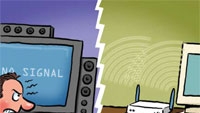Reader Feedback

Interference revisited
Editor:
Regarding your July 2007 editorial, “Could interference kill DTV?,” I have a parallel question. Remember AM radio? I remember when there was nowhere in the country where you could not tune into AM radio. Today, with more stations on the air, you hear less of it. Is it that difficult to figure out?
Tom Norman, CPBE
Burst
BNC
Editor:
For the Broadcast Engineering December 2006 Freezeframe answer, you listed Baby N Connection as the definition of BNC, but I believe BNC actually stands for Bayonet Neill - Concelman. The “N” was named after Paul Neill of Bell Labs, and the “C” was named after engineer Carl Concelman. Also, TNC stands for — you guessed it — Threaded Neill-Concelman connector.
The following is a short blurb about BNC from Wikipedia:
“The connector was named after its bayonet mount locking mechanism and its two inventors, Paul Neill of Bell Labs (inventor of the N connector) and Amphenol engineer Carl Concelman (inventor of the C connector), and is much smaller than both the N and the C connectors. Other acronyms the BNC has picked up over the years include: ‘Baby Neill- Concelman,’ ‘Baby N connector,’ ‘British Naval Connector, and ‘Bayonet Nut Connector.’
Get the TV Tech Newsletter
The professional video industry's #1 source for news, trends and product and tech information. Sign up below.
The basis for the development of the BNC connector was largely the work of Octavio M. Salati, a graduate of the Moore School of Electrical Engineering of the University of Pennsylvania (BSEE ’36, PhD ’63). He filed a patent in 1945 (granted 1951) while working at Hazeltine Electronics Corporation for a connector placed on coaxial cables that would minimize wave reflection/loss.”
Pete Putman
ROAM Consulting
HDTVExpert.com
Rochester, MN
Metadata interchange
Brad Gilmer:
I enjoyed your article “Metadata interchange” in the July issue of Broadcast Engineering.
Clearly, standardized metadata is becoming increasingly necessary. Sure, today we may have standards, but I think we have too many of them. I hope the Task Force’s work on a standardized wrapper goes well, and that its recommendations are universally adopted. Standards aren’t really standards if everybody’s got a different one!
Mike Langner
New Mexico
Brad Gilmer responds:
The industry has talked about the importance of metadata for many years. I think everyone realized that it is vital, but users are just beginning to harness the power this can bring to their facilities.
Why did it take so long? Well, first users had to convert from tape-based technology to files. Then they had to get the video and audio to interchange. (It turns out that this was no simple feat!) Finally, they were in a position to use metadata to aid workflows, but they had to get past proprietary solutions. All of this took some time, but I think you will see major advances in this area in the coming years.
I read your June 26, 2007 article from the online magazine, Broadcast Engineering, entitled, “CEA publishes DTV interface standards”. What the CEA is doing to help the consumer is great, except for one thing. While they have published these standards designed to help viewers (a vast majority of which are already confused when it comes to this subject) set up and control DTV accessories, they don’t make it easy for the consumer to get the information found within the standards, for they charge them for the information. Making it publicly accessible at no cost to the consumer would be a much better way of helping the consumer.
Joe Gombos
JBA Consulting Engineers
Low Voltage Designer
